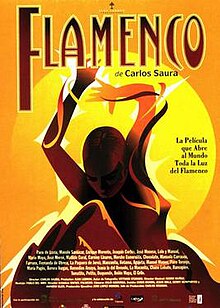Flamenco (1995 film)
| Flamenco | |
|---|---|

Theatrical release poster
|
|
| Directed by | Carlos Saura |
| Produced by | Juan Lebrón |
| Written by | Carlos Saura |
| Starring |
|
| Music by | Isidro Muñoz |
| Cinematography | Vittorio Storaro |
| Edited by | Pablo del Amo |
|
Release date
|
|
|
Running time
|
102 minutes |
| Country | Spain |
| Language | Spanish |
| Box office | $449,964.00 |
Flamenco is a 1995 Spanish documentary film directed by Carlos Saura with camerawork by cinematographer Vittorio Storaro. The film is entirely musical and dancing vignettes, composed and photographed on a sound stage.
Flamenco is a documentary that includes performances from some of the best flamenco singers, dancers and guitarists. Helped by cinematography by Vittorio Storaro, director Carlos Saura brings with this film the "Light of Flamenco to the World".
As a hall fills with performers, a narrator says that flamenco came from Andalucia, a mix of Greek psalms, Mozarabic dirges, Castillian ballads, Jewish laments, Gregorian chants, African rhythms, and Iranian and Romany melodies. The film presents thirteen rhythms of flamenco, each with song, guitar, and dance: the up-tempo bularías, a brooding farruca, an anguished martinete, and a satiric fandango de huelva. There are tangos, a taranta, alegrías, siguiriyas, soleás, a guajira of patrician women, a petenera about a sentence to death, villancicos, and a final rumba. Families present numbers, both festive and fierce. The camera and the other performers are the only audience.
This film shows a world of flamenco—singing, dancing and guitarplaying melded into an intense, enclosing and dramatic space. Song, guitar and dance are blended in inventive ways. They are performed sometimes a cappella, extending the guitar playing in subtle and intense "solos" accompanied often by hand-clapping or knuckles rapped on a table. These dancers have learned the technique but they make the flamenco their own. Here we see children dancing with their parents; and grandparents demonstrating that flamenco imbues the spirit with a graceful power that does not age. At the end, we see the form of flamenco symbolically passed through a class of aspiring dancers.
Performances by: Paco de Lucía, Joaquín Cortés, Manolo Sanlúcar, Lole y Manuel, La Paquera de Jerez, Fernanda de Utrera, José Menese, Enrique Morente, José Mercé, Farruco y Farruquito, Ketama, Manzanita, Maria Pagès and many others at the old Seville train station.
...
Wikipedia
